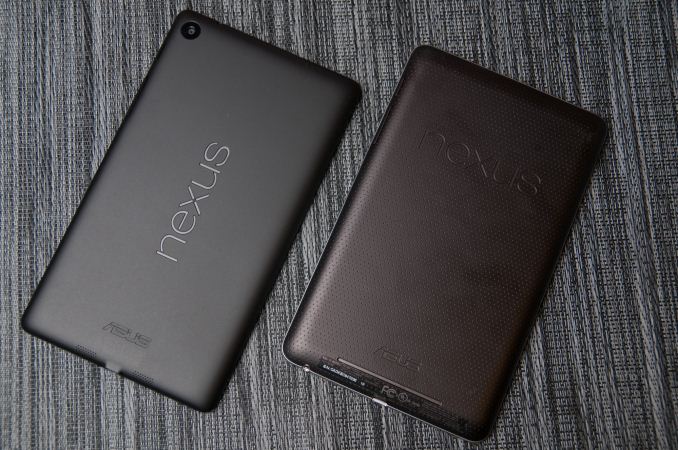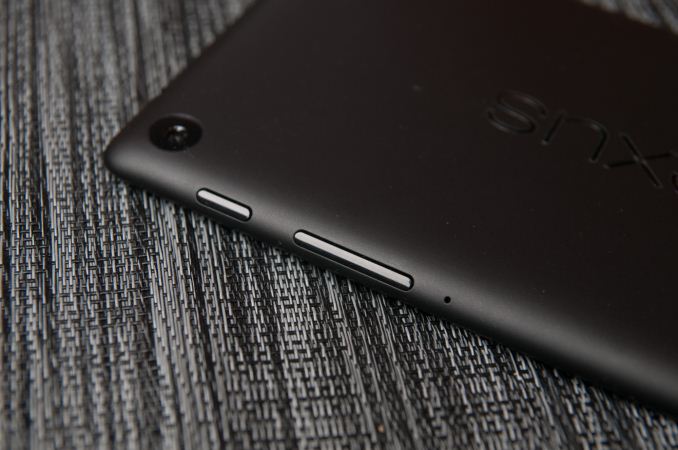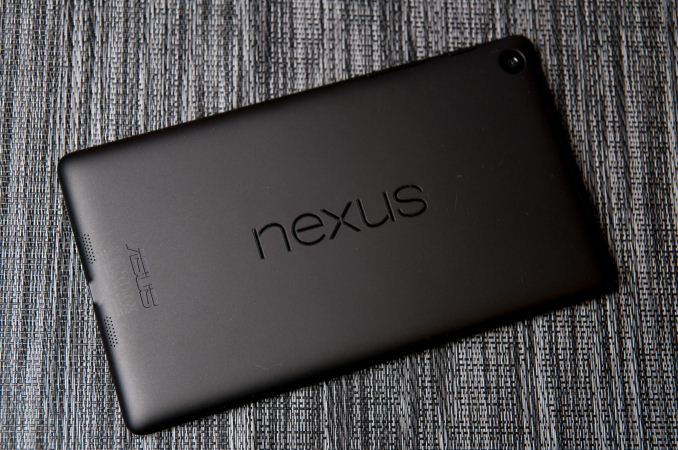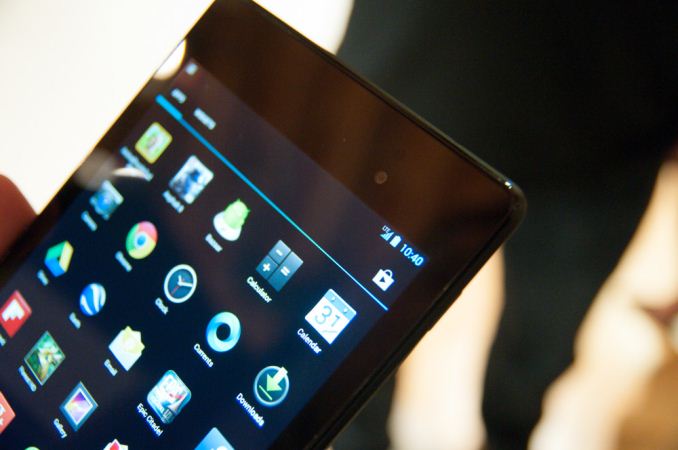Nexus 7 (2013) - Mini Review
by Brian Klug on July 27, 2013 12:54 AM EST- Posted in
- Tablets
- Snapdragon
- Qualcomm
- Android
- Mobile
- APQ8064
- Nexus 7
- Android 4.3

At an event in San Francisco, Google announced an updated version of the popular Nexus 7 tablet which first appeared at last year’s Google I/O. The big new features update the Nexus 7 platform with inclusion of a 1.5 GHz Snapdragon S4 Pro (APQ8064) SoC, 1920x1200 display by JDI (Japan Display Inc), as well as 5 MP rear facing camera, 1.2 MP front facing camera, stereo speakers, dual band WiFI, wireless charging (Qi) and a thinner and lighter chassis. It’s a major update that keeps the competitive price point that made the original Nexus 7 appealing (the lineup starts at $229 for the 16 GB model) while bringing numerous much-needed improvements that people have asked for.
First off, it’s shocking how much of a difference the change in thickness and weight makes. The new Nexus 7 feels considerably lighter and thinner in the hand than its older counterpart. Gone is the textured rubberized (almost driver glove-like) material on the back, in its place a flat, uniform soft touch material. There’s Nexus emblazoned in landscape on the rear, which is a bit puzzling next to the 90 degree rotated ASUS down below. It irritates my OCD sensibilities seeing the two logos inexplicably perpendicular and right next to each other, but I suppose Google thinks this helps emphasize how much the Nexus 7 and Android platform are really tablet-friendly now, with landscape view support throughout the core apps.
The rear facing camera is in the extreme top left, next to the power and volume rocker buttons, and top speaker. The Nexus 7 build and finish does feel a bit more plasticky to me this time around, but that’s almost expected given the price point, and it isn’t a major dig on the hardware at all. That’s not to say it isn’t sturdy or well put together, but just that the original Nexus 7 left a stronger impression on me last time, and I’ve been spoiled by the ASUS FonePad since then. The edge chamfer also helps the Nexus 7 feel a bit more like the Nexus 4 with its rounded edge. The previous Nexus 7 came to a point that could be a bit sharp at times.
What’s a little awkward is how tall the bezel at top and bottom looks on the Nexus 7, I’m warming up to it. On paper the new Nexus 7 is smaller in almost every dimension, in reality the elongated aspect ratio is definitely a bit pronounced here. There’s also still a notification LED well hidden under the glass at bottom in the center.
On the back is the new 5 MP rear facing camera, buttons (which hug the edges), a microphone port, and speakers. The speakers fire out the back of the Nexus 7 and look like they have good separation (obviously the best that the device’s size affords – top and bottom), but I don’t have a good feel for just how loud they go quite yet. Having stereo is a dramatic improvement for the audio part of video and multimedia consumption, and Android does 5.1 virtualization out the speakers as well. On the connectivity side of things there’s microUSB at the bottom with SlimPort video out, and a 3.5mm audio jack. I know a lot of people were hoping for inclusion of line in on the 3.5mm audio jack but I can confirm it isn’t present.
| Nexus 7Tablet Specification Comparison | ||||
| ASUS Nexus 7 (2012) | ASUS Nexus 7 (2013) | |||
| Dimensions | 198.5 x 120 x 10.45mm | 200 x 114 x 8.65mm | ||
| Chassis | Plastic + Rubber back | Plastic + Soft Touch back | ||
| Display | 7-inch 1280x800 IPS | 7.02-inch 1920x1200 IPS | ||
| Weight | 340 g | 290 grams (WiFi), 299 grams (LTE) | ||
| Processor | 1.3 GHz NVIDIA Tegra 3 (T30L - 4 x Cortex A9) | 1.5 GHz Qualcomm Snapdragon S4 Pro (APQ8064) | ||
| Memory | 1 GB | 2 GB DDR3L | ||
| Storage | 8 GB / 16 GB | 16 GB / 32 GB | ||
| Battery | 16 Whr | 15.01 Whr | ||
| WiFi/Connectivity | 802.11b/g/n, BT, NFC | 802.11a/b/g/n, BT 4.0, NFC | ||
| Camera | – |
5.0 MP Rear Facing w/AF 1.2MP Front Facing |
||
| Wireless Charging | – | Yes (Qi Compatible) | ||
| Pricing | $199/$249 |
$229/$269 (WiFi 16/32 GB) $349 (LTE) |
||
My only real complaint with the new Nexus 7’s in hand feel and build is with the power button and volume rocker, which feel somewhat mushy to me. I had issues taking screenshots even at times. It’s a minor gripe, but with only three buttons on the whole device, and generally good execution by ASUS with buttons on tablets, it surprised me. I guess I also do miss that racing glove-inspired texture in the soft touch on the back of the original Nexus 7.
| Nexus 7 (LTE) Band Coverage | |||||
| Model | GSM/EDGE Bands |
WCDMA Bands (HSPA+ 42) |
LTE Bands (UE Category 3) |
||
| North America Nexus 7 LTE |
Quad Band (850 / 900 / 1800 / 1900 MHz) |
HSPA+: 850/900/1900/2100/AWS(1700/2100) MHz (Bands: 1/2/4/5/8) | 700/750/850/1700/1900/2100 MHz (Bands: 1/2/4/5/13/17) | ||
| Europe Nexus 7 LTE | 800/850/1700/1800/1900/2100/2600 MHz (Bands: 1/2/3/4/5/7/20) | ||||
There’s a version of the Nexus 7 with 32 GB of storage and LTE onboard for $349 which will appear ‘in the coming weeks’ and includes support for AT&T, T-Mobile, and Verizon LTE in the USA on one piece of hardware. This is the first single SKU solution I’m aware of with coexistence of Bands 13 and 17 (Verizon and AT&T respectively) on the same device, which is awesome. There’s a model with Bands 3, 7, and 20 for Europe as well, so they’re not left out of the LTE fray. I had a chance to quickly get a look at the new Nexus 7 with LTE, which includes a microSIM tray and was working on one of the LTE networks in San Francisco just fine.
As far as I know, the Nexus 7 LTE solution is Qualcomm’s MDM9215 with a WTR1605L transceiver inside, and doesn’t necessarily include any of the new RF360 brand of front end hardware (like the power amplifier with integrated antenna switch or tunable front end), since MDM9x15 only works with QFE1320 (Bands 1,2,3/4,5,8,20). Still, that makes it all the more impressive, and Google deserves considerable kudos for further pushing such unprecedented interoperability, since in a tablet you do have more area to include discrete power amplifiers and filters.




















252 Comments
View All Comments
Impulses - Sunday, July 28, 2013 - link
As the happy owner of an OG Transformer, I'm looking forward to upgrading to the new Nexus 7 (I've come to realize I prefer a smaller tablet for my uses), the TF will probably go to my father. Happy to support ASUS either way as I'm generally happy with their entire Android tablet strategy.Affectionate-Bed-980 - Saturday, July 27, 2013 - link
As much as I love quick reviews, please make sure that you follow up on your promises for a full review... soon. Where's that GS4 review Part 2 for example?FergusMackenzie - Saturday, July 27, 2013 - link
This look like an excellent tablet with one exception. 16:10 is a horrible aspect ratio on a tablet. Why does no major android manufacturer make a tablet with 4:3 aspect ratio?Broo2 - Saturday, July 27, 2013 - link
Most tablets are going 16:9 as that fits the 1920x1080 HD video standard and vendors probably get many complains from users watching HD 16:9 movies with black bars and the static sized Magazines/Comics/PDFs are a secondary concern.16:10 is not perfect for magazines/comics/PDFs, but it is better than 16:9; I have only seen the new Nexus 7 and the B&N Nook HD+ with this aspect ratio. The only 4:3s are the iPad and eInk eBook readers... :(
guidryp - Saturday, July 27, 2013 - link
Most Android tablets are 16:10, not 16:9.B&N Nook HD+ is not 16:10. It is 3:2. Which is a pretty good compromise. We need more like that.
Bob Todd - Monday, July 29, 2013 - link
Unless it was something odd with Cyanogenmod 10.1.2 on the Nook HD+, I'd have concerns about 3:2 in general. I always like the extra pixels, but I think that aspect ratio was rare enough that it tripped up a fair number of games that weren't tested properly on 3:2 (but worked fine on 16:9/16:10).charleski - Saturday, July 27, 2013 - link
In terms of rendering the varying aspect rations of books, comics and magazines 3:2 is probably the best compromise, but 16:10 isn't far off. 4:3 and 16:9 are both much worse.guidryp - Saturday, July 27, 2013 - link
It's irrelevant for regular novels which are just text, so you can read them on any ratio.Comics and Magazines would be good on 3:2, if your screen is big enough to show the whole page at once, which I would argue 7" isn't. If it isn't then matching ratios hardly matter. If you are going to be panning and zooming, I would definitely prefer 4:3 over 16:9/16:10.
Impulses - Sunday, July 28, 2013 - link
I like 16:10 in portrait a lot for web browsing and email, which is like 80% of my tablet use. Not sure why you'd prefer anything else for that or for media... 16:9 is noticeably narrower, grab any Win 8 tablet and see.Yofa - Saturday, July 27, 2013 - link
the original nexus 7 had a 1.2mp front-facing camera. that point is omitted from the comparison chart.